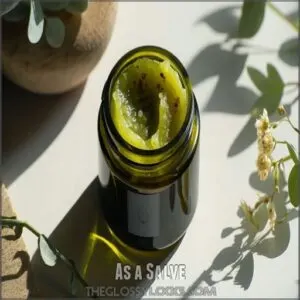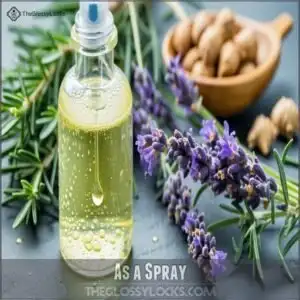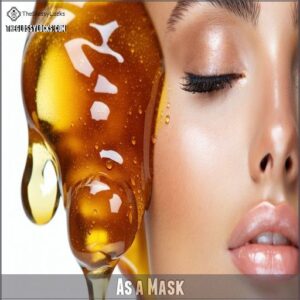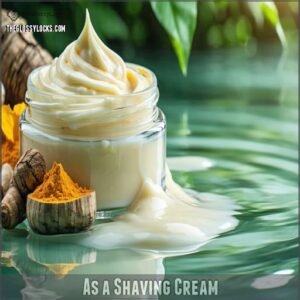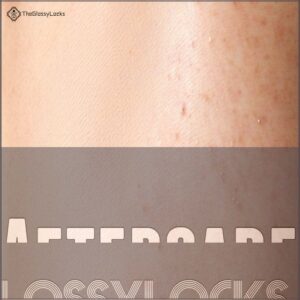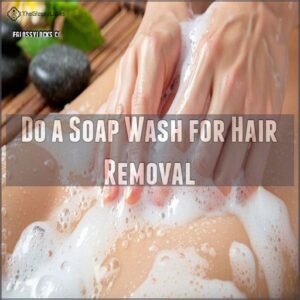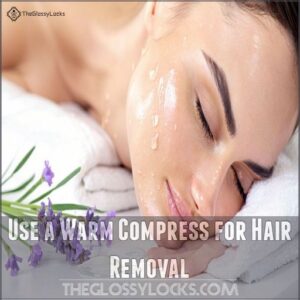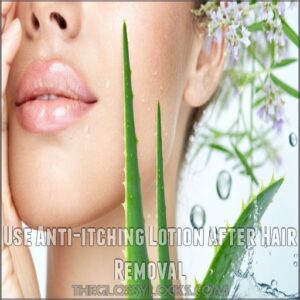This site is supported by our readers. We may earn a commission, at no cost to you, if you purchase through links.
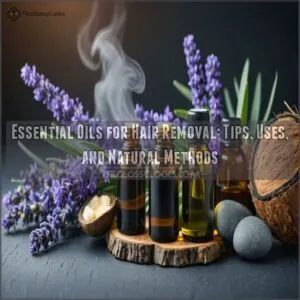
Lavender and tea tree oils, when used regularly, may reduce hair growth over time. Combine a few drops with a carrier oil like coconut or jojoba, and apply twice daily—but patience is key since results take months.
You can also try DIY remedies, like a turmeric and lavender oil mask or a soothing aloe vera and essential oil salve for post-removal care. Always patch test first to avoid irritation.
Looking for smoother, softer results? Stay tuned for tips on effective aftercare and alternative methods!
Table Of Contents
- Key Takeaways
- What Are Essential Oils for Hair Removal?
- How to Use Essential Oils for Hair Removal
- Alternative Methods for Hair Removal
- Do a Soap Wash for Hair Removal
- Wear Loose, Dry Clothing After Hair Removal
- Use a Warm Compress for Hair Removal
- Try Aloe Vera for Hair Removal
- Do a Hydrogen Peroxide Wash for Hair Removal
- Use Anti-itching Lotion After Hair Removal
- Frequently Asked Questions (FAQs)
- Which essential oil is best for hair removal?
- What is the best oil for men’s hair?
- Can essential oils remove hair?
- Is peppermint essential oil good for hair removal?
- How to remove facial hair with essential oil?
- Are essential oils good for your hair?
- Which essential oil removes hair?
- What oils stop facial hair growth?
- Does lavender and tea tree oil remove hair?
- What oil is used for removing hair?
- Conclusion
Key Takeaways
- You can slow hair regrowth naturally with essential oils like lavender and tea tree when applied consistently twice daily for months.
- Always dilute essential oils with carrier oils like coconut or jojoba to avoid skin irritation, and patch test before use.
- DIY remedies, like a turmeric-lavender mask or aloe vera salve with essential oils, soothe skin and enhance the hair removal process.
- After hair removal, proper aftercare with essential oils, moisturizing salves, and loose clothing helps reduce irritation and improves skin healing.
What Are Essential Oils for Hair Removal?
Essential oils for hair removal aren’t magic potions, but they offer a natural, gentle option if you’re looking for smoother skin.
For instance, lavender and tea tree oils are popular choices, thanks to their anti-androgenic and soothing properties, which can help slow hair regrowth over time. When mixed with carrier oils like coconut or jojoba, these blends can nourish your skin while working on those pesky hairs. Some essential oils, like argan oil, also have benefits such as hair hydration and softening.
Consistency is key—apply twice a day for several months to see noticeable results.
While this approach takes patience, it can save you some cash compared to pricey salon treatments.
But remember, oil safety matters: always do a patch test to avoid reactions. Essential oils may not work overnight, but paired with proper care, they’re a promising step in the right direction for natural hair removal.
How to Use Essential Oils for Hair Removal
You can use essential oils for hair removal in several ways, like as a salve, spray, or mask.
Each method focuses on reducing hair growth over time.
while soothing your skin.
As a Salve
Mix turmeric, tea tree oil, lavender or rosemary essential oils, and aloe vera gel for an effective DIY hair removal salve.
This blend soothes skin while targeting unwanted hair.
Gently massage it on clean skin, then rinse after 15 minutes.
Store your salve in a cool, dry place, and test a small area first to avoid reactions.
As a Spray
A quick spritz of an essential oil hair removal spray might be just what you need.
DIY recipes combine tea tree, turmeric, and lavender oils with distilled water and aloe vera gel.
Maintaining a healthy hair and scalp pH balance, around 4.5-5.5 naturally lightening hair. It’s a gentle, skin-nourishing option for all skin types.
Spray safety precautions matter—patch test first to avoid irritation or unexpected reactions.
As a Mask
Ready to pamper yourself? A face mask can gently exfoliate, soften hair, and leave your skin glowing.
Try this DIY honey mask: mix 2 tablespoons of honey with 3 drops of Turmeric or Lavender essential oil.
Apply evenly, let it sit for 20 minutes, then rinse with warm water.
Use this natural hair removal method twice a week for noticeable results. It’s painless, effective, and your skin will love you!
As a Shaving Cream
For a silky, natural shave, whip up a DIY recipe blending essential oils like turmeric with shea butter.
It’s one of the best oils for skin sensitivity, offering smooth application and long-term effects.
Essential oils for hair removal make shaving gentle and effective.
Aftercare
After hair removal, treat your skin to some TLC!
Moisturize with a gentle essential oil salve—try lavender or tea tree to soothe irritation, reduce redness, and prevent ingrowns. Start with 3-5 drops diluted in sterile water or carrier oil.
Exfoliate lightly with pads to minimize bumps and keep skin smooth.
Finish by patting dry with a clean towel. These aftercare steps can help lock in moisture and prevent those pesky red bumps!
Alternative Methods for Hair Removal
Sometimes, you might want to explore natural alternatives to traditional hair removal methods. Exfoliating, homemade masks, and waxing can offer effective, budget-friendly options with minimal side effects.
Exfoliating
Exfoliating is like hitting the refresh button for your skin—it removes dead cells, helps prevent ingrown hairs, and delivers smoother results.
Use gentle tools like natural luffa sponges or try exfoliant types like BHA liquid. If you’re into DIY scrubs, turmeric oil can reduce swelling and improve circulation—plus, it’s budget-friendly.
Brush lightly in the hair’s growth direction to avoid irritation. Sensitive skin? Look for mild options like Paula’s Choice Exfoliant Liquid.
Stick to exfoliating 2-3 times a week to keep your skin glowing but not over-scrubbed. Remember, overdoing it can lead to skin irritation, so always listen to your skin’s limits!
Masks
Masks are a gentle way to tackle hair removal while treating your skin. Natural ingredients like clay or activated charcoal work wonders for loosening hair and exfoliating dead cells. Add essential oils for even more benefits.
- Mask ingredients: Mix honey, turmeric, or lavender oil for smoother results.
- Mask frequency: Use once or twice weekly to avoid irritation.
- Mask benefits: They’re soothing, exfoliating, and can help slow down regrowth naturally.
Waxing
Waxing isn’t just about smoother skin—it’s a commitment to longer-lasting results.
Prep smartly, exfoliating beforehand to reduce waxing pain and improve hair removal.
Whether you’re using hard or soft wax, match the method to your skin type and hair thickness.
At-home waxing is convenient, but investing in the best wax simplifies the process.
Enhance the experience by applying essential oils hair removal salves before waxing for hydration and smoother application.
Post-wax, soothe redness and irritation with calming oils like lavender.
Stick to a healthy waxing frequency—every 3-6 weeks—to avoid over-irritation and maintain your skin’s glow.
Consider professional body waxing services like full body waxing treatments
Do a Soap Wash for Hair Removal
Sometimes unwanted hair removal methods can leave your skin feeling rough, irritated, or just in need of a little love. That’s where a nourishing soap wash steps in—it’s kind of like giving your skin a relaxing spa day right at home. By using natural ingredients and essential oils, you can create a soothing remedy that cleanses and protects your skin.
Certain oils like lavender, tea tree, and peppermint are great choices for their calming, antimicrobial, and anti-inflammatory benefits. To use, lather the soap onto your skin and gently massage it over areas you’ve treated. Rinse thoroughly with warm water and pat dry.
Here’s how to keep things safe and effective:
- Choose gentle, natural soaps that contain moisturizing ingredients.
- Avoid overly scented or chemical-heavy products to reduce the risk of irritation.
- Stick to once or twice a day for a healthy balance.
- Watch for skin reactions and patch-test new products.
- Always hydrate with a light moisturizer after washing.
Enjoy smoother skin while embracing this natural hair removal routine!
Wear Loose, Dry Clothing After Hair Removal
Choosing the right clothing after hair removal isn’t just about comfort—it’s about giving your skin the TLC it needs. Loose, dry clothing made from breathable fabrics like cotton helps your skin breathe and prevents irritation. Tight clothes can trap moisture, irritate follicles, or even lead to pesky ingrown hairs. So, swap those skinny jeans for flowy pants or a cozy loose tee. To prevent future waxing issues, proper wax application techniques are key, such as using the right wax removal methods.
Here’s a quick guide:
| Clothing Choice | Why It Works |
|---|---|
| Loose Cotton Shirts | Allows skin to breathe and reduces irritation risk. |
| Flowy Pants | Prevents chafing and ingrown hairs. |
| Avoid Tight Clothing | Stops moisture buildup and irritation. |
| Stick to Breathable Fabrics | Improves airflow for healing. |
For aftercare, apply essential oils like lavender post-treatment—they’re perfect for soothing those sensitive spots. Just dab lightly, avoiding areas like the face or bikini lines if skin feels extra delicate. Don’t forget, a gentle wash with a clean cloth (not scrubbing!) keeps bacteria at bay. These simple steps make aftercare a breeze, helping your skin heal quickly and worry-free.
Use a Warm Compress for Hair Removal
A warm compress might be your skin’s best friend after hair removal. It’s an easy way to soothe irritation, reduce redness, and even prevent those pesky ingrown hairs. The gentle heat from the compress can improve blood flow to the area, speeding up healing and reducing inflammation. Plus, it helps open pores, making it easier for your skin to absorb soothing aftercare products, like essential oils for hair removal. Lavender oil or aloe vera are great choices to use along with a compress for their calming and natural benefits.
To get started, soak a clean cloth in warm (not hot!) water. Wring it out so it’s damp rather than dripping, then gently press it onto the treated area. Avoid scrubbing or applying too much pressure—you don’t want to irritate the skin further, especially in areas like your bikini line or face. Keep it on for a few minutes, re-wetting the cloth in warm water as needed.
When you’re done, rinse your skin to remove any leftover product and pat it dry. With regular use, you’ll notice improved skin texture and fewer problems with inflammation or ingrown hairs. It’s a simple, natural hair removal aftercare step that can make a big difference.
Try Aloe Vera for Hair Removal
Aloe vera is like a soothing balm for your skin after hair removal. Whether you’ve shaved, waxed, or plucked, its cooling, anti-inflammatory properties work wonders at calming irritated skin and reducing redness. Beyond soothing, aloe vera promotes skin regeneration and repairs tissue, so your skin feels soft, smooth, and healthy.
For the best results, apply a generous layer of room-temperature aloe vera gel to freshly cleaned, slightly damp skin. Think of it as giving your skin a protective hug against irritation or potential infections.
Proper wax application techniques also play a significant role in reducing skin irritation and ensuring effective hair removal.
Want to really up your skincare game? Mix aloe vera with essential oils like lavender, which has calming effects, or rose, which enhances circulation and might help healthier hair regrowth. This DIY aloe vera recipe doesn’t just save money—it gives you glowing skin while using natural remedies for hair removal that feel luxurious and safe. Aloe vera safety is a plus, too, as it’s gentle on most skin types.
Regular use can tame those pesky red bumps and leave your bikini line looking flawless. Say goodbye to pricey products and hello to smoother, happier skin—all with a little nature’s magic and a little know-how!
Do a Hydrogen Peroxide Wash for Hair Removal
A hydrogen peroxide wash can be a surprisingly effective way to support your hair removal routine. While it’s not a permanent solution, it offers benefits like reducing irritation, fighting bacteria, and lightening hair over time. Plus, it’s easy to do at home with just a few supplies.
Additionally, exploring natural alternatives like Cyperus Rotundus oil hair removal oil can be beneficial for those seeking long-term results.
Mix 3–4 tablespoons of 3% hydrogen peroxide into 8 ounces of water in a spray bottle—simple, right? After removing hair through shaving, waxing, or another method, spritz the solution directly onto the area. This can soothe the skin and even prevent pesky ingrown hairs. For the best results, you’ll want to apply it once or twice daily until the irritation subsides or the skin feels smoother.
Here are some quick tips to keep things under control:
- Always do a patch test. Hydrogen peroxide can irritate sensitive skin, so check how your skin reacts before going all in.
- Moisturize after use. Pair it with a natural moisturizer, like one with coconut oil, to avoid dryness.
- Watch for reactions. If you notice redness, peeling, or discomfort, ease up to prevent further irritation or damage.
Remember, this method works best for lighter hair and small areas, and while results are gradual, it’s a safe, budget-friendly option.
Use Anti-itching Lotion After Hair Removal
After hair removal, your skin might feel itchy or irritated, but the right aftercare can help, like using aloe vera products after waxing aloe vera after waxing. Applying an anti-itching lotion is a simple way to soothe sensitive skin and keep it feeling good. Look for lotion types with natural ingredients like aloe vera or shea butter—they’re great for calming irritation and adding moisture.
If itchy skin is driving you crazy, go for a cream with menthol. It’s cooling and provides quick relief while helping damaged skin recover. For extra care, essential oils for hair removal, such as tea tree oil, can be added to your routine. Tea tree oil is especially useful if you’re dealing with folliculitis or want to prevent ingrown hairs that appear after shaving or waxing.
You can even whip up a DIY balm at home—blend equal parts aloe vera gel and shea butter for a light, soothing aftercare solution.
Frequently Asked Questions (FAQs)
Which essential oil is best for hair removal?
Lavender oil stands out for hair removal, thanks to its anti-androgenic properties.
Pair it with tea tree oil for better results.
Apply consistently for months, and don’t skip a patch test to avoid irritation!
What is the best oil for men’s hair?
Picture running your fingers through soft, healthy hair—argan oil makes it possible.
Packed with antioxidants and fatty acids, it hydrates, strengthens, and tames frizz.
It’s your all-in-one solution for smoother, shinier locks.
Can essential oils remove hair?
Essential oils can’t directly remove hair, but they may slow growth with consistent use.
Lavender and tea tree oils show promise, especially for hormonal imbalances.
Results take time, so patience and regular application are key.
Is peppermint essential oil good for hair removal?
Peppermint oil won’t directly remove hair.
Its cooling sensation can soothe skin after hair removal.
It’s more of a comforting sidekick than a solution, so pair it with traditional methods or other essential oils.
How to remove facial hair with essential oil?
Like dusting off an old mirror, mix lavender and tea tree oil with carrier oil.
Apply twice daily, and stay consistent for months.
Patch test first, and remember, patience pays off with natural methods.
Are essential oils good for your hair?
Essential oils can be great for your hair when used right.
Lavender supports growth, tea tree reduces dandruff, and peppermint stimulates scalp health.
Always dilute with carrier oils, patch test, and apply consistently.
Which essential oil removes hair?
Lavender and tea tree oils don’t exactly remove hair, but they slow growth when used consistently.
Studies suggest their anti-androgenic properties help reduce hair.
Apply daily for months and pair with traditional methods for results.
What oils stop facial hair growth?
You can try lavender, tea tree, or spearmint oil to slow facial hair growth.
Apply consistently for months to see results.
Remember, patience is key, and always do a patch test before using.
Does lavender and tea tree oil remove hair?
It’d be nice if oils acted like a magic delete button, wouldn’t it?
Lavender and tea tree oils don’t instantly remove hair but can slow growth over time, especially with consistent use, thanks to anti-androgenic properties.
What oil is used for removing hair?
Lavender and tea tree oils are popular for slowing hair growth over time.
They won’t zap hair instantly but can help with consistent use.
Mix them with a carrier oil for safe, daily application.
Conclusion
Using essential oils for hair removal is like planting a seed—it requires patience and consistency for results to grow.
Lavender and tea tree oils can help reduce regrowth naturally when used daily with care.
Pair these with soothing aftercare like aloe vera or hydrating salves to keep your skin happy and smooth. Experiment with DIY remedies, but always patch test first.
Embrace the process, listen to your skin, and enjoy the journey to healthier, low-maintenance hair care. Essential oils for hair removal


